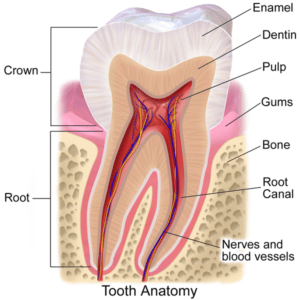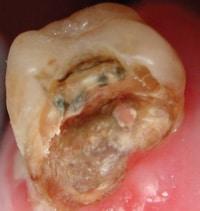When folks hear about curing tooth decay naturally, some seem to picture a perfectly healed tooth that looks exactly like the others around it, white and strong and unblemished.
Unfortunately, that’s not how it works.
 A human tooth is made of three main layers of tissue. The smooth, thin, glossy layer on the outside is enamel. It’s the hardest tissue in your body, and it protects the softer layer of dentin below it and the living pulp of the tooth within.
A human tooth is made of three main layers of tissue. The smooth, thin, glossy layer on the outside is enamel. It’s the hardest tissue in your body, and it protects the softer layer of dentin below it and the living pulp of the tooth within.
It’s also the only tissue your body can’t make more of. Once your teeth are formed, you no longer have any of the cells you need to create enamel. Those ameloblasts are only present during tooth development, when they secrete proteins that will later mineralize and become enamel.
This is why when you have decay that eats all the way through to that middle layer of dentin, you need to get a filling. We remove the decay and add biocompatible, tooth-like material (composite) to “restore” the tooth’s natural appearance and function.
Still, every so often we hear from someone who’s read online about healing cavities and believe they don’t need to get cavities treated or fillings replaced. Are they wrong?
Not entirely.
In his landmark book Nutrition and Physical Degeneration, Weston Price showed how the decay process can be stopped with nutritional intervention. He noted how it could spur remineralization of the dentin. But he never claimed that any tooth would be restored to its former glory this way. Here’s what he did say:
When a tooth has a deep cavity of decay, the decalcified dentine has about the density of rotten wood. With an adequate improvement in nutrition, tooth decay will generally be checked provided two conditions are present: in the first place, there must be enough improvement in the quality of the saliva; and in the second, the saliva must have free access to the cavity. Of course, if the decay is removed and a filling placed in the cavity, the bacteria will be mechanically shut out. One of the most severe tests of a nutritional program, accordingly, is the test of its power to check tooth decay completely, even without fillings. There are, however, two further tests of the sufficiency of improvement of the chemical content of the saliva. If it has been sufficiently improved, bacterial growth will not only be inhibited, but the leathery decayed dentine will become mineralized from the saliva by a process similar to petrification. Note that this mineralized dentine is not vital, nor does it increase in volume and fill the cavity. [emphasis added]
This is what that mineralized dentin looks like (in this case, found under a lost restoration):

See how rough and gnarled it looks compared to the smooth enamel covering the rest of the tooth? This is not living tissue. It is the body’s best attempt to protect the tooth and keep it from becoming more deeply diseased.
Of course, there’s a lot of exciting research going on that suggests that one day, we may be able to help the body “do the impossible” and actually regrow teeth, enamel and all. Some experimental methods involve stimulating dental stem cells to differentiate over a small scaffold. Others involve stimulating those stem cells with a laser. So far, such studies have been done in animals only, and so much research remains to be done. As one recent paper summed up,
Promising researches on stem cells for dental tissue engineering were performed during the last 15 years, but we are still far from the complex regeneration of a tooth. Several limitations persist and must be overcome before the use of stem cells in dental clinic, notably in terms of safety, capacity to isolate homogenous stem cell populations and to efficiently orientate their differentiation towards an odontogenic fate.
Being able to regrow whole teeth from stem cells would be an amazing achievement. But’s it’s still years away from reality. For now, there’s no regrowing what’s lost. You can’t generate new enamel. You can’t remineralize enough dentin to completely fill a cavity. You can’t get your amalgams removed and expect to regrow the tissue you lost when they were originally put in.
But we do understand the appeal of thinking otherwise. As we say, the absolute best dental material is your own natural tooth structure. And that’s why it is so important to do everything you can to protect it: eat right, practice good hygiene, have regular dental visits, get enough exercise, sleep, and rest, manage stress – in short, lead a lifestyle that promotes health over disease of all kinds.
That is entirely within your power.
Tooth diagram by BruceBlaus, via Wikimedia Commons;
arrested caries image via Dentistry Today